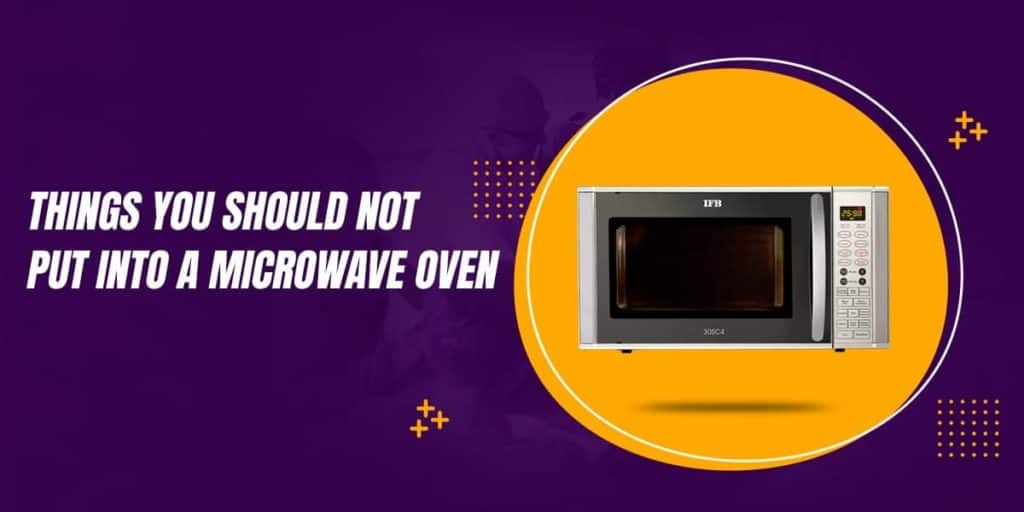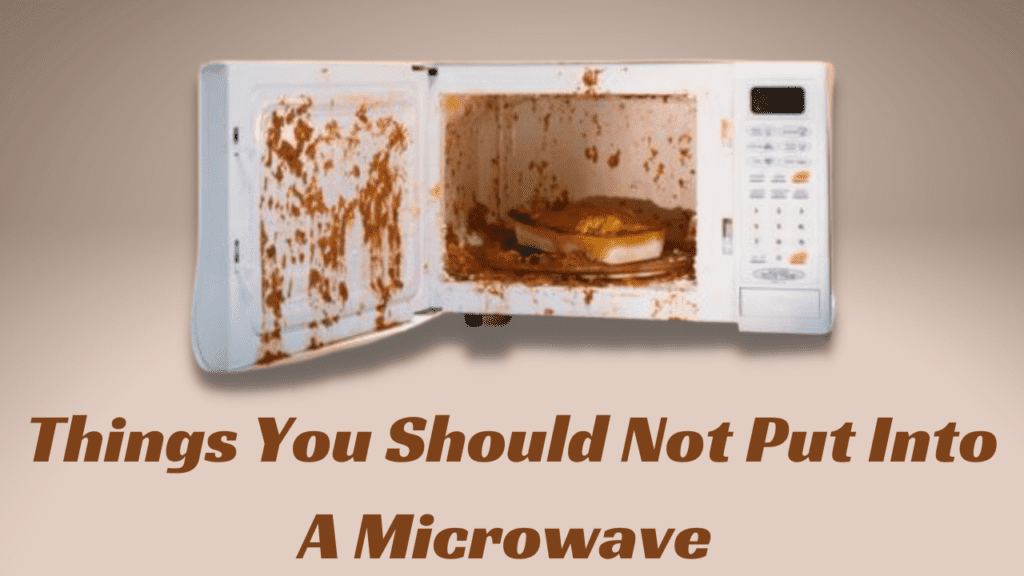Contents

Looking to know about the Things You Should Not Put Into A Microwave? Read on.
When you are constantly on the move, you use the microwave more than ever. These 13 things should never be put in your favorite kitchen appliance.
Getting things done quickly is important, especially when it comes to food. It seems the more you have to do, the less time you want to spend on meal preparation. Although you may not realize it, your microwave puts in just as much work as you do.
While it might be one of the most convenient appliances for warming up your food, it doesn’t mean it’s meant to withstand everything.
A key component of microwave safety is knowing what does and doesn’t belong in the appliance. Here are a few of the things you should NEVER put in the microwave.
13 Things You Should Not Put Into A Microwave
Aluminum Foil
Metal in a microwave is a huge no-no! Many microwaves are lined with metal, which acts as a mirror, bouncing microwaves around the box until they’re absorbed by the food.
Metal is a great conductor of electricity; it reflects heat rather than absorbing it. At best, a little metal in the microwave prevents food from cooking properly. At worst, the resulting heat will create sparks that could cause a fire and render your microwave unusable.

China With Metallic Accents
Fine china has no place in the microwave, especially if it is trimmed with metal accents like platinum or gold bands.
That lovely metal trim is just that—metal. Before you pop those cups and plates in the microwave, look for a microwave-safe message on the bottom. If your dish is not clearly marked as such, set it aside.
Squeeze Bottles
Most condiment containers, including honey, hot fudge, and mustard squeeze bottles, do not microwave safe. The soft plastic from which the bottles are made may melt, explode or catch fire.
If you want to microwave crystallized honey, scoop a little out into a microwave-safe container first. If you’d rather heat the entire bottle, dunk it in boiling water for a few seconds until the honey liquefies.
Breast Milk
Busy new moms and working mothers have taken to freezing breast milk and thawing it as needed. The practice is perfectly safe, provided it’s done correctly. Microwaving frozen breast milk, on the other hand, is not a good idea.
Microwaves heat milk unevenly, which creates “hot spots” in the milk that can scald the baby. Besides some research has found that microwaving breast milk destroys immune-boosting proteins. The FDA suggests heating breast milk or formula under hot, running tap water or in a pan of hot water, removed from the stove burner.
Eggs
It seems like there are hundreds of gadgets for sale in stores and online that promise to safely and easily cook eggs in the microwave, but don’t waste your money. No matter which gizmo you use, microwaving eggs is a fast track to a big mess.
The rapid heat generated by microwaves creates steam inside the egg, which often causes it to explode. If you want eggs, stick to the stove-top.
Plastic Containers
Plastic containers and microwaves are not a good marriage. Certain types of plastic containers—butter tubs, yogurt cups, cream cheese tubs, and even reusable food storage containers—are designed to hold refrigerated items but aren’t made to withstand the heat of a microwave.
When heated, these containers can melt and release estrogen-like chemicals, including Bisphenol A, or BPA into your food. Transfer your food to a microwave-safe glass plate or bowl to avoid unpleasant chemical contamination.
Styrofoam
When your morning coffee goes cold, it can be tempting to heat it up in the microwave. If that coffee is in a styrofoam cup, back away from the microwave. Styrofoam is a type of soft plastic that melts when exposed to the high heat and rays of the microwave.
That melted styrofoam releases harmful chemicals into your food—so cups, bowls, and take-out containers never belong in your microwave.
It’s important to note that styrofoam is particularly bad for the environment and most curbside recycling programs won’t accept the material for pick up. Pass on putting styrofoam in the microwave but also skip on bringing it home in the first place.
Travel Mugs
Travel mugs typically are constructed of stainless steel or plastic—two items that should never be microwaved.
The stainless steel blocks microwaves from warming the liquid inside the mug and could spark or cause a fire. Plastic mugs, on the other hand, may melt or release harmful chemicals when heated.
Paper Bags
Those convenient popcorn bags you put in the microwave may give the impression that it’s safe to heat paper bags. Not so. Not all paper bags are created equal.
Popcorn bags are constructed with a material containing susceptors that are designed to absorb the rays from the microwave and keep the paper from catching fire. Paper lunch bags or grocery bags do not have these susceptors, making them a hazard in the microwave.
Chinese Take-out Containers
Another item that should never go from fridge to microwave? Chinese take-out containers. The handles on these ubiquitous containers are usually made of metal.
Though small, these handles can cause sparks or catch fire when heated in the microwave. Transfer your tasty leftovers to a glass plate or bowl before heating them up for a quick meal.
Hot Peppers
Hot peppers and microwaves are a recipe for pain. Like eggs, peppers can explode when heated too quickly in the microwave and can even catch fire. The other problem with peppers is capsaicin, the chemical that makes them hot and spicy.
When microwaves hit the pepper, capsaicin turns into an aerosol resulting in a homemade pepper spray. This can burn your eyes and skin the moment you open the appliance door. If you’re cooking hot peppers use the stove-top, oven, or broiler and always handle it with care.
Frozen Meat
Many home cooks think thawing frozen meat in the microwave is a helpful hack to speed up dinner prep. In reality, this method produces uneven results and can actually cause bacteria to grow, resulting in food-borne illnesses.
The reason is that different thicknesses of the meat absorb microwaves at different rates, leaving some areas cooked while other areas are still frozen. The safest way to thaw meat is to defrost it in the refrigerator overnight.
